This past weekend I participated in great class, Combative Pistol 1&2 led by Chris Fry of MDTS hosted by the Marbletown Sportsmen’s Club in Stone Ridge. I was very happy with this class and the instructors. We had 15 students of mixed skill levels and 3 instructors. This was a good ratio for this type of class. The range had 8 shooting positions, so we shot in 2 relays. This led to just about perfect pacing as you had just enough time to top off mags and get a drink while the other relay shot an exercise.
We started off with a brief introduction of the instructors and an overview of basic safety rules. It was made clear that safety was the top priority and any student could be removed if safety rules were violated. Chris then explained his philosophy and approach. His methods are based on no-nonsense techniques that get the job done with a minimum of complexity. He also maintains very similar stances and movements with pistol, carbine, knife and empty hand. Such simplification leads to a common set of muscle memory movements that are more easily ingrained. Additionally, Chris is secure enough in his methods that he doesn’t get upset if you have a different way that you like to do something. A common theme that was repeated throughout the class was “it is not THE way, it is A way”. Chris also strives to provide effective training at an affordable price.
Next we covered some basics like grip, sights and trigger control as well as stance and position. The shooting stance or “Dynamic Contact Position” was demonstrated as well as the basic low ready stance. The dynamic contact position is designed to not only proved a stable base for “administering ballistic counseling”, but also to allow rapid movement and absorb the energy of a rushing attacker.
This was not a lecture class, so after this, we moved out to the range, where the rest of the class would be conducted. We practiced shooting from the dynamic contact position. This was basic slow fire, and the instructors evaluated and addressed any basic problems. This was from 3 and 5 yards. Since most self defense shootings involve very close ranges, we never shot at anything further than 7 yards. It was emphasized that each distance has it’s own requirements for time and accuracy. At the longer range you have a bit more time and the target is smaller, so you need to take the time to acquire a sight picture and carefully fire. At 3 yards you just cover the target with the back of the slide and fire.
We then moved on to some gun-handling exercises, loading, unloading and reloading. Everything was conducted as if it were being done in a gun fight., there were no casual reloads here. The point being that you will perform how you practice, so every technique should be done as it would need to be done in a fight. We loaded up mags with 1, 2 & 3 rounds and mixed them up so we wouldn’t know when a reload would be needed.
The next block emphasized the need to have a plan for your defensive responses, in fact several plans. You can’t just keep blazing away until the problem, hopefully, goes away. The first response is the “Standard Defensive Response” and consists of 2 shots to the “center of visible mass” (read that as chest). We drilled this at all ranges with their appropriate pacing. At this time we also added the after action drill. Basically this is looking around to make sure that there are no more threats. It’s designed to break the affect of stress induced tunnel vision and keep you aware of the larger situation.
The last item for Combative Pistol 1 was an introduction to “Bilateral Weapon Operation”. This is really just a fancy term for shooting with your support hand (“don’t say weak hand, there is nothing weak on me”). It included a method for transferring the pistol and practice shooting and manipulating it with the support hand. This was quite difficult and it’s really eye opening how hard simple things get when you have to do them with the wrong hand. More practice needed here (and everywhere else too).
Combative Pistol 2 began with the tactical reload, reload with retention, or a half a dozen other names. This is incorporated into the after action drill as a method of topping off the gun when there is a lull in the fight. This concept has a certain amount of controversy as it requires some fine motor control (which goes away under stress). Some say that you’re better off just letting the magazine drop and retrieving it after the reload if time allows. I’m not sure how I feel about it as I can see both sides of the argument, but I won’t go too far down that path.
The next subject was more defensive responses. These are needed when the standard response doesn’t produce the desired affect, for example when your attacker is wearing body armor. The “Failure to Stop Response” was first. This consists of 2 shots center mass, and 1 to the melon. This is sometimes called the “Mozambique drill” or just “2 to the chest and 1 to the head”. The important thing to remember in this drill is that the head shot has to count. So you have to take a little more time with it. The final defensive response that we covered was the “Non-Standard Defensive Response”. This consists of the usual 2 shots center mass, followed by 4 shots to the pelvis. The idea here is that it will, at a minimum, hunch your attacker over, destroying his balance and momentum. Ideally it would also break the pelvis destroying skeletal support, making it impossible to stay standing and mobile. This exercise really burned up some ammo as each volley put 6 rounds into the target.
Now we covered another ready position,”The Diamond”, also known as “Position Sul”. This puts the gun very close to your body for moving in close quarters in a structure or among teammates. We practiced shooting from this, and the other ready positions.
Our last chunk of instruction involved moving under fire. We covered the “Combat Side Step”, which is used to quickly take you off the line of attack. If an attacker is charging it’s better to not be there when he gets there. We also covered “Speed Kneeling” where you drop to one knee. This is useful when shooting from behind cover so you don’t keep popping up in the same spot. Also you present a smaller target, and if working in a team, allow the shooter behind you to engage the target as well.
The concluding exercise involved a combination drill encompassing everything we learned. Different instructions were called out and we performed them flawlessly, of course. This really piled some stress on as there were many tasks to do and you had to listen to what the instructions were, retain them, and perform them. Remembering to deal with reloads and clearing any malfunctions (“ammunition management is your responsibility!”).
Lastly we concluded the class with a debrief. We reviewed what we learned and any questions were answered. Chris went around the group and ask each one of us if there was anything he could do to improve the class, and he sincerely meant it, listening intently to the suggestions. I suggested that we do introductions of all the students at the beginning of the day and perhaps have name tags. It was a little uncomfortable not knowing who everyone was. Chris apologized for not doing this and assured us that he would take it into account in the future. The instructors were open to suggestions and improvements, yet still firm. If you let your gun go empty, there was someone quickly shouting at you to fix it fast. While it was obviously a training environment it was clear that we were training to fight for our lives. Standing there looking at an empty chamber is not a good way to win that fight.
I learned a lot from this class, and in total we shot about 500 rounds. My Springfield XD ran like a top with no failures. I will continue to practice the skills and drills that were taught and improve upon my own skill set. I would also recommend taking any of Chris’ courses. In fact, I’ve already signed up for a Carbine course in about a month. The techniques are well thought out and clearly explained and demonstrated. I’m also going to do more training of non-firearm skills. Chris really encourages his students to be well rounded and be able to handle situations without hardware. I look forward to future classes and I’ll continue to write about them.
There were 2 people whose guns failed. One had a backup and the other was lucky enough to borrow one. It makes sense to bring 2 guns to any training exercise like this as it would be a shame to have to bow out of the class because a $2 part on your gun failed.
Thanks also to the Marbletown Sportsmen’s Club for hosting and providing a hearty lunch.
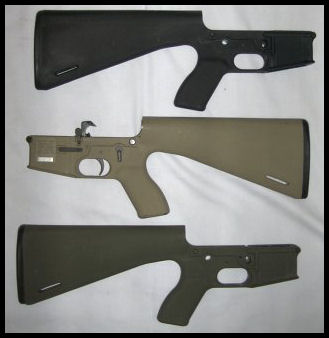 The Cavarms lowers differ from the traditional in 2 major ways. Most obviously, they are 1 monolithic piece incorporating the lower receiver, grip and stock. The other way is not so obvious until you pick it up. They are molded from an advance polymer, (ok, plastic). This results in a significant weight savings over the traditional lower, a full pound lighter. Another benefit is the ability to mold them in any color imaginable. They have done the obvious blacks, greens and tans, but also yellow, pink, blue, neon green, and even glow in the dark!
The Cavarms lowers differ from the traditional in 2 major ways. Most obviously, they are 1 monolithic piece incorporating the lower receiver, grip and stock. The other way is not so obvious until you pick it up. They are molded from an advance polymer, (ok, plastic). This results in a significant weight savings over the traditional lower, a full pound lighter. Another benefit is the ability to mold them in any color imaginable. They have done the obvious blacks, greens and tans, but also yellow, pink, blue, neon green, and even glow in the dark!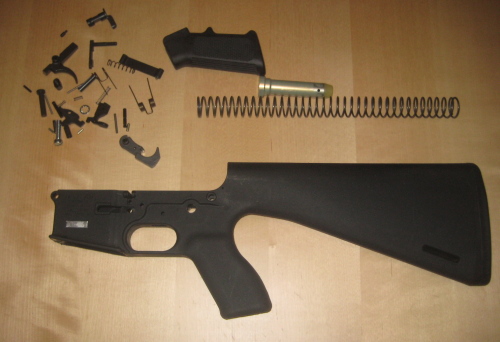
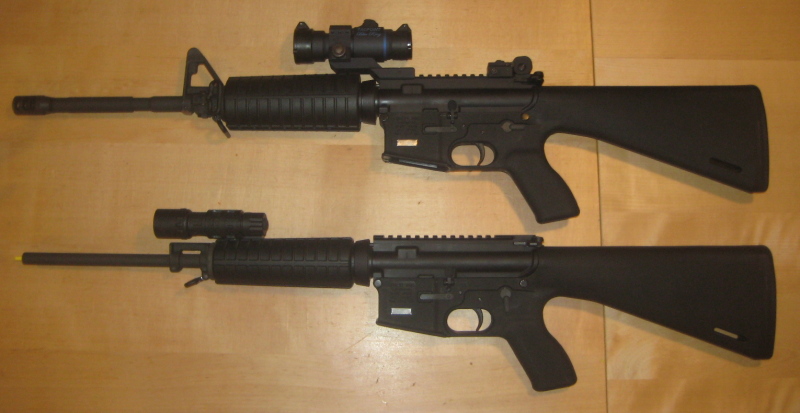
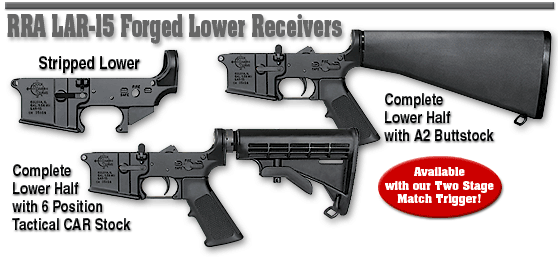
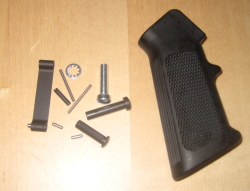

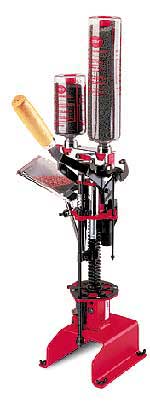 Took a little while to get everything working smoothly, but once I had the rhythm worked out, I was cranking out shells pretty quickly. I only dropped shot on the floor twice 😉
Took a little while to get everything working smoothly, but once I had the rhythm worked out, I was cranking out shells pretty quickly. I only dropped shot on the floor twice 😉

